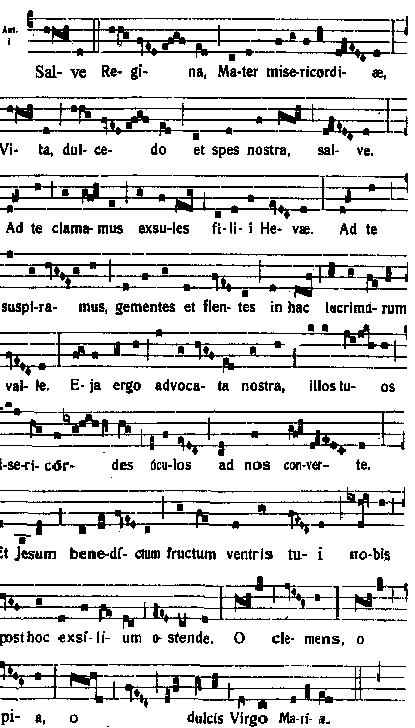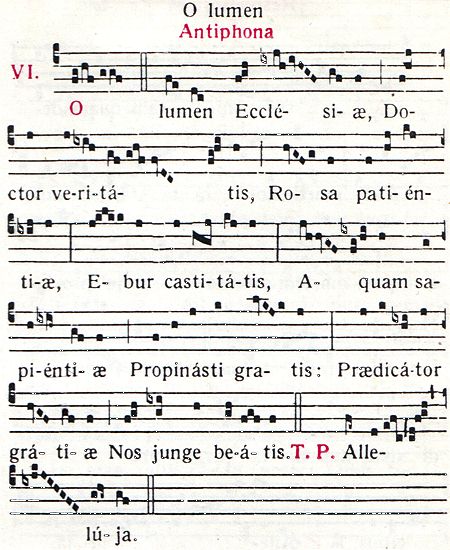




















 |
Dominican Music
The Salve Regina
Part of Our Dominican Heritage
Click here to listen:
Sung by the
Dominican Sisters of St Cecilia, Nashville, TN
Sung by the Brothers
Devotion to the Blessed Virgin Mary has been a prominent feature of Dominican
spirituality from the Order's beginnings. Our beautiful Dominican Salve Regina
is one testament to our filial love for the Mother of the Church and the
Protectress of the Order.
Every night, the brothers sing Compline before bed, concluding with the
Dominican Salve Regina. The singing of the Salve Regina after Compline in honor
of the Virgin Mary is one of the oldest traditions in the Order, dating back to
the first generations of Dominican friars. In fact, the Church's practice of
singing the Salve (or some other Marian antiphon) after Compline grew out of
this early Dominican practice. In 1221, very soon after the death of St.
Dominic, Blessed Jordan of Saxony instituted the procession, which was to
accompany the singing of the Salve. This was done in response to a crisis in the
community. In Bologna at this time several Dominican houses were having trouble
with assaults of the devil, and a certain brother, by the name of Bernard, was
suffering acutely. His difficulty caused disturbance to the whole community. It
was decided that the aid of our Heavenly Mother would be invoked. The singing of
the Salve was thereafter done in procession seeking the Blessed Mother’s special
protection. Immediately, peace was restored to the monastery. The practice
spread rapidly to other Dominican houses, as well as to other religious orders
in the Church.
Hail Holy Queen, Mother of mercy
our life, our sweetness and our hope!
To thee do we cry, poor banished chidren of Eve,
To thee do we send up our sighs,
Mourning and weeping in this valley of tears.
Turn, then, o most gracious advocate,
Thine eyes of mercy toward us
and after this our exile
Show unto us the blessed fruit of thy womb, Jesus.
O clement, o loving, o sweet Virgin Mary.
Salve Regina, Mater Misericordiae,
vita, dulcedo, et spes nostra, salve!
Ad te clamamus, exsules filii Hevae,
ad te suspiramus, gementes et flentes,
In hac lacrimarum valle.
Eja ergo, Advocata nostra,
Illos tuos misericordes oculos ad nos converte
Et Jesum, benedictum fructum ventris tui,
Nobis, post hoc exilium, ostende,
O clemens, O pia, O dulcis Virgo Maria.

One night St. Dominic came upon a heavenly trio as he made his way through
the dormitory of the brethren. Three radiant women came toward him as the one in
the center made the sign of the cross with an asperges brush dipped in holy
water, blessing the cells of the sleeping friars. The astonished St. Dominic
knelt at their feet and looking toward the most beautiful woman in the middle,
asked her who she was. The Blessed Mother replied, “I am she whom you invoke
every evening, and when you say, 'Eia ergo advocata nostra' ('Turn then, our
advocate'). I prostrate before my son for the preservation of this Order.” When
St. Dominic inquired about the other holy women with her, she identified them as
St. Cecilia and St. Catherine of Alexandria.
It is from this account that the custom spread throughout the Order to kneel
as the words “Eia ergo advocata nostra” are sung. While the community is
kneeling, the hebdomadarian (a designated leader of prayer) walks down the
aisle, blessing the brethren or sisters with holy water.
Martyrdom in Sandomir
In 1260, in Sandomir, Poland, Blessed Sadoc and forty-eight friars were
murdered by the Tartars, a barbarian tribe. The Blessed Mother’s promise of
protection was evident as the community had been miraculously warned the day
before their death that they were to be martyred. In preparation, each friar
went to Confession and Mass, then performed, as perfectly as possible, his
ordinary duties. It was not until evening that the Tartars invaded the
monastery. The Dominicans were killed as they sang the Salve. It is this
incident that prompted the tradition of singing the Salve at the deathbed of the
brethren. This practice continues at St. Cecilia Motherhouse in our infirmary
after our chaplain anoints the sister who is in her last hours and the community
recites the prayers for the dying. Many sisters after a long fruitful religious
life have left this world with the Salve ringing in their ears.
O lumen
Light of the Church
Teacher of truth
Rose of patience
Ivory of chastity
You freely poured forth the waters of wisdom.
Preacher of grace, Unite us with the blessed.

--------------------------------------------------------------------------------
From "Life of St. Dominic," Chapter XII, by Henri Lacordaire
“One evening, Dominic was praying in the church until midnight, at which hour he
entered the corridor where the Friars were asleep in their cells. Having
finished his business, he resumed his prayers at the end of the corridor where
the Friars were asleep in their cells. Having finished his business, he resumed
his prayers at the end of the corridor, when chancing to turn his eyes to the
other end, he beheld three women approaching, the center on being the most
beautiful and venerable. One of her companions carried a magnificent vase, and
the other an aspersorium, which she presented to her mistress, who sprinkled and
blessed all the Friars save one. Dominic, after noting who the Friar was,
advanced to meet the woman, who had already reached the middle of the corridor,
near the lamp suspended in that spot. He prostrated himself at her feet, and
although he had recognized her, entreated her to tell him her name. At that same
time, the beautiful and devotional anthem of the Salve Regina was not yet sung
in the monastery and nunnery of the Order in Rome, but only recited, kneeling,
after Compline. The woman replied, ‘I am she whom you invoke every eve, and when
you say, Eia ergo, advocata nostra, I prostrate myself before my Son, entreating
Him to protect this Order.’ The blessed Dominic then asked who her two
companions were, on which the Blessed Virgin said, ‘One is Cecilia, and the
other Catherine.’ The blessed Dominic then inquired the reason for her omitting
to bless one of the Friars, and she replied, ‘Because he was not in a becoming
posture.’ Then having finished her round, and sprinkled and blessed the Friars,
she disappeared. The blessed Dominic returned to the spot where he had been
praying, and hardly had he recommenced his devotions when he was raised in
spirit to the presence of God. He beheld the Lord, having at his right hand the
Blessed Virgin, who seemed to Dominic to be robed in a sapphire-colored mantle.
Looking around and discerning Religious of every Order but his own, he began to
weep bitterly, not daring to approach our Lord or his Blessed Mother. Our Lady
motioned him to draw near, but he dared not comply until encouraged by our Lord.
Then he approached and prostrated himself weeping bitterly. The Lord said, ‘Why
weepest thou so bitterly?’ and he replied, ‘Because I see members of every Order
but my own.’ The Lord said to him, ‘Dost thou wish to see thy Order?’ He
tremblingly replied, ‘Yes, Lord;’ and the Lord rested His hand on the shoulder
of the Blessed Virgin, saying to Dominic, ‘I have confided thy Order to my
mother.’ Then He added, ‘Wilt thou indeed see thy Order?’ to which Dominic
replied, ‘Yes, Lord.’ Then the Blessed Virgin unfolding her mantle in Dominic’s
sight, so that it covered the whole of the celestial abode, he beheld beneath it
a multitude of his children. The blessed Father prostrated himself to render
thanks to God and to our Lady, and the vision disappeared. As he recovered
consciousness, the bell was ringing for Matins, and when they were ended, he
convoked a chapter of his Friars, and discoursed to them on the love and
veneration they ought to have to the Blessed Virgin, and among other things he
related this vision. At the close of the chapter, he privately took aside the
brother whom Our Lady had not blessed, and gently asked him if he had not kept
back something in the general confession he had made. He replied, ‘Holy Father,
my conscience accuses me of nothing, save that last night, when I awoke, I found
I had been sleeping with no garments on.’ At Saint-Sixtus the blessed Dominic
related his vision to Sister Cecilia and the others, as if it had been beheld by
another person, but the Friars present made a sign to the sisters that it was
Dominic who had seen it. It was on this occasion that the blessed Dominic
enjoined that, wherever they slept, the Friars should wear their girdle and
their sandals.”
Other Music Resources from the efforts and grace of Mr.Smith.
The Suarez Edition of the Dominican Gradual (422 pgs pdf)
Graduale ixta Ritum S. O. P. Emmanuelis Suarez permissu editum. Rome: S. Sabinae,
1950. This is the last edition of the Dominican Gradual and probably the most
correct edition in terms of the medieval manuscripts of the chant.
The Gillet
Edition of the Nocturnum (123 pgs pdf)
Nocturnum; sive, Antiphonarium S. O. P. pro Nocturnis Horis Majorum Solemnitatum.
Stanislai Gillet permissu editum. Rome: In Hospitio Magistri, 1936.
This is the only modern edition of the Night Office ever published. It covers
the major feasts only and gives the chants corrected to conform to the medieval
melodies but the form of the offices are those of the Post-Pius X Breviary, not
the medieval Office. There is available on the web three modern electronic
editions of the Night Office. They are for the ferial Psalter and commons only.
Pre-Pius X Ferial
Nocturnal (20 pgs pdf)
Post Pius X
Ferial Nocturnal (83 pgs pdf)
Nocturnal for
Common Offices (206 pgs pdf)
Cormier Edition of the Processional (467 pgs pdf)
Processionarium Iuxta Ritum Sacri Ordinis Praedicatorum. Hyacinthi Cormier issu
recognitum et editum. Romae: Curia Magistri Generalis, 1913.
The Gillet Edition of the Diurnal Antiphonarium (1290 pgs pdf)
Antiphonarium Sacri Ordinis Prædicatorum Pro Diurnis Horis. Martini Stanislai
Gillet permissu editum. Romæ: In Hospitio Magistri Generalis, 1933:
Hymns of the Dominican Missal and Breviary, (355 pgs pdf )
Aquinas Burns, O.P., (St. Louis: Herder, 1943)
|

